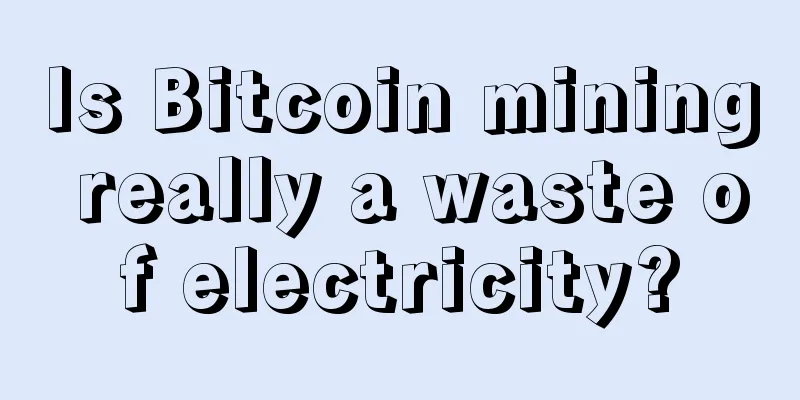Is Bitcoin mining really a waste of electricity?

|
Bitcoin is a distributed, peer-to-peer system. There is no "central" server and no point of control in the network. Bitcoins are generated by a process called "mining," which is a mechanism for competing to solve a class of mathematical problems in the process of verifying Bitcoin transactions. Any participant in the Bitcoin network (anyone running the full Bitcoin protocol stack) can become a miner, and they can use the processing power of their own computer to verify and record transactions. Bitcoin's mining mechanism decentralizes the central bank's currency issuance and clearing mechanism, and the central bank's function is replaced by this global competition mechanism. On average, every 10 minutes in the Bitcoin network, someone will complete the verification process of the transactions generated in the past 10 minutes and receive a new Bitcoin reward. It runs 24 hours a day, 7 days a week, and the work it completes requires miners around the world to contribute a lot of processing power. This processing power requires energy, and at 75 exahashes per second, the Bitcoin network currently consumes about 7-8 gigawatts of electricity, which is equivalent to about $9 million per day (or about $3.3 billion per year) of energy, at a marginal cost of 5 cents per kilowatt-hour (roughly estimated). Based on the national average in the United States, the Bitcoin network consumes the same amount of electricity as about 6 million homes. Yes, this is indeed a powerful energy drain, but it is also the force that protects and supports the Bitcoin network. How can so much energy consumption be justified? When a billion people use Bitcoin, what does it consume? The US dollar works just fine, right? That's the problem. These resources are working to solve a problem that most people don’t understand, which makes it challenging to justify the derived costs. To help ease the pain for environmentalists and social justice warriors, we often point to counter-narratives to make it seem more palatable: A large portion of Bitcoin's energy consumption comes from renewable sources. Bitcoin will drive innovative development of renewable energy technologies and resources. The energy consumed by Bitcoin, if not wasted, is burned into the atmosphere. Bitcoin only consumes the energy that the free market would consume at the free market rate. Bitcoin consumes energy resources. Without Bitcoin, there would be no economic development. The very nature of Bitcoin’s energy requirements will increase the efficiency of the energy grid. The simplistic view that Bitcoin’s energy consumption is necessarily wasteful or necessarily harmful to the environment falls apart. However, the cost of mining can never be justified without recognizing the magnitude of the monetary problem Bitcoin is intended to solve. Bitcoin represents a solution to the systemic problems we have inherited within the monetary framework, which relies on energy consumption to function. The stability of an economy depends on the functioning of money, and Bitcoin provides a far more sound monetary framework, which is why there is no more important long-term use of energy than securing the Bitcoin network. So rather than detailing the many individual rebuttals that go against the mainstream narrative, let’s focus on the first principle issue itself: the monetary issue or the global quantitative easing (QE) issue. 1. Functions of Money The problem with money is huge, though most people don’t realize it. Most people feel it in their daily lives, but can’t pinpoint the root cause. Many people work harder, work longer, go into debt, and still barely get by. There has to be a better way out of this mess, but in order to identify a solution, the problem must first be seen and understood, and the problem with our money and the impact it has on society is pervasive. Without getting too deep into what money is, we can more easily describe the role of money in society. Money is a good thing that facilitates economic coordination between parties, otherwise there would be no basis for cooperation. In short, it is money that makes society work, it allows us to accumulate capital and make our lives better, and this capital serves different people in different forms. Money is the root of all evil, as the old saying goes, but as Hayek more aptly described it in The Road to Serfdom, money is the agent of freedom. “Money is one of the greatest instruments of freedom ever created by man.” More specifically, money is a good thing that allows specialization and the division of labor. It allows individuals to pursue their own interests. It lets individuals communicate their preferences to the world, both in work and in leisure, creating the "range of choices" we all take for granted. Our modern economy is built on the freedom that money provides, and the end result is a highly complex and specialized system. To simplify the concept, Milton Friedman explained the complexity of the pencil, detailing how no one person could produce a standard pencil independently. He detailed the wood required, the saw, the steel for the saw, the iron ore, the lead, the rubber for the eraser, the brass ring, the yellow paint, the glue, etc. The production of a single pencil requires the coordination and cooperation of thousands of people, including people who do not speak the same language, who may practice different religions, and who may even hate each other when they meet. The ability to cooperate is the determining factor of the price system and the economic function we call money. Abstracting from the pencil, now consider the complexity of our modern economy. From cars to airplanes, from the internet to cell phones, and even to your local grocery store. Modern supply chains are so complex and specialized that they require the coordination of millions of people to make these basic functions happen. The coordination of all of this activity that drives global trade is only possible through the power of money. 2. Venezuela’s Living Example Venezuela is one of the most oil-rich countries in the world, but Venezuela's currency is over-inflated, causing currency depreciation to distort the currency's price mechanism, thereby creating an economic imbalance. As economic coordination deteriorates, complex supply chains are disrupted, resulting in a decline in the supply of physical goods (such as food on the shelves, oil production, etc.), creating an imbalance between supply and demand. Fundamentally, this is the result of Venezuela no longer having a stable currency to coordinate economic activity and production, which has led to a deteriorating economy. As more money is created, real goods become relatively scarce compared to the money supply, which causes the function of money to collapse. As physical goods become increasingly scarce, individuals have less incentive to hold money, and instead choose to sell it as quickly as possible, causing a rush on basic necessities and causing excessive monetary inflation, which in turn causes the economy to deteriorate. What is happening in Venezuela is devastating, and you might think that the situation in developed countries is not as unstable as Venezuela, nor subject to similar monetary bases. But we are currently on the same edge, and in the case of the United States, the Fed has expanded the monetary base 23 times from $180 billion in 1984 to a peak of $4.2 trillion after the third round of quantitative easing. Due to the nature of the Fed's credit-based economy, this economic distortion of devaluation occurs gradually until the financial crisis suddenly occurs, and the government launches a large-scale quantitative easing policy in order to "mitigate" the crisis. History, if we are honest, shows how ill-tempered those who run our economy from central command are. Despite acknowledging the huge gaps in their ability to understand the impact of actions on the real economy, their response is to continue down the same path, but on a larger scale, while expecting different results: this is the definition of insanity. Our current choice is between two contrasting options: (A) a centralized form of money that is designed to debase itself, or (B) a digital currency with a fixed supply that carries a cost in the form of energy consumption, but a positive externality that will be long-term economic stability. 3. Bitcoin achieves economic stability through energy consumption Future economic stability is the fundamental reason why Bitcoin’s monetary security system requires a lot of energy consumption, especially when alternative currencies (fiat and gold) are structurally flawed. If we wait for signs of hyperinflation, we’ve already lost. But Venezuela is not just an example of hyperinflation, it is also a living example of how important energy production is to the functioning of society. Everything we consume in our daily lives requires some energy input. The coordination of these energy inputs relies on the reliability and stability of the currency we use. Ignore your morning coffee for a minute and think about the basics: clean water, sanitation, food, medicine, basic healthcare, etc. The coordination of resources to provide these basic services relies on a functioning monetary system. When the monetary system breaks down, social coordination and even social structure begins to break down with it. If the basis of all trade is energy, and if we need money to coordinate trade, then the highest and best use of this energy should first be to protect the monetary system. Secure the basis of trade, then focus on all the derivatives. Any concerns about how much energy Bitcoin consumes or will consume are misguided. This is not to say that we should sacrifice electricity that would otherwise power our homes; rather, we will never have the electricity to power those homes if we don’t have a reliable monetary system to coordinate economic activity and integrate resources. In practice, Bitcoin will not actually compete with the energy resources that fuel the basic production and consumption functions of our economy (which are not zero-sum); rather, Bitcoin’s function as a monetary system will ensure that those energy needs can continue to be met. What is harmful to society is that more countries degenerate into economic and humanitarian disasters like Venezuela, where basic health and human services cannot be reliably delivered. This is not to present a grim vision or a dystopian future; rather, it is to illuminate the importance and interconnectedness of the functions of money and energy in complex, highly specialized economies. Bitcoin represents a backup switch for the current architecture of the global financial system, and will soon become its primary engine. Leaving aside the systemic risks that currently plague our financial system, Bitcoin is a fundamentally more sound monetary system. Moreover, it is secured by the production and consumption of energy. You don’t have to believe that the fate of the dollar will be that of the Venezuelan bolivar to appreciate the importance and interaction between the stability of the monetary function and the production of energy that provides basic economic necessities. Moreover, even the possibility of hyperinflation, with its inherently highly asymmetric risks, is small relative to the cost of Bitcoin’s energy consumption. Bitcoin will consume any and all energy resources needed to ensure the security of its monetary network, which is inherent to the fundamental need to hold Bitcoin as money. The more people value its long-term stable development, the more energy it consumes. Ultimately, this consumption will ensure that all other energy consumption derivatives will continue to be met, which is why there is no more important long-term energy use than protecting the Bitcoin network. Paying for economic stability and the economic freedom that a stable monetary system provides is the real reason for the energy that Bitcoin should and will consume, everything else is a distraction from your focus. |
<<: Bitcoin falls to $8,000 again. Do you really understand the halving bull market?
>>: F2pool launches BFC mining
Recommend
What does a mole on the chin mean?
Everyone has moles. They may grow on the chest or...
DTCC CEO: Blockchain is a once-in-a-lifetime opportunity
Blockchain technology is quickly being touted as ...
What kind of facial features will a woman have an affair with?
Having good luck in love is good, but once it’s o...
A mole that makes people envious for a lifetime
A mole that makes people envious for a lifetime M...
How to read the fortune line of a wealthy woman's palm
How to read the fortune line in women’s palms? As...
Chainlink Opens Oracle Module to All Substrate, Polkadot, and Kusama Chains
To support these teams, teams in the Polkadot eco...
What does Tan Lang sitting in the life palace represent?
Tan Lang is a Class A main star, also known as Ji...
Bitcoin is becoming more and more expensive, and holding the currency has become a symbol of status?
Bitcoin, a popular cryptocurrency that is also co...
The shape of the face shows a person's wealth
The shape of the face shows a person's wealth...
Filecoin network is about to be upgraded. Let’s talk about how to calculate Filecoin gas fees
In our previous article, we explained the origin ...
Whether you are prone to sentimentality
Sentimental is mostly used to describe a person w...
Your complexion shows how lucky you are lately
Your complexion shows how lucky you are lately Co...
What does it mean if the career line on the left hand is missing from the right hand?
The career line is a line on the palm that contai...
Jiang Ge case trial opens, don’t make close friends with people with these facial features!
The "Jiang Ge case" will be heard in Ja...
What is the overall fortune of a woman with upturned corners of her mouth?
There is a kind of facial expression that makes p...









